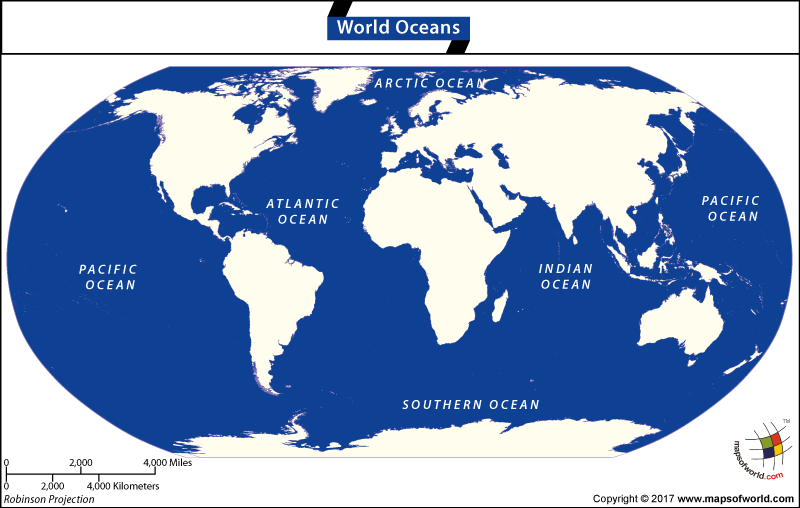Oceans of the World

The word “ocean” comes from the Latin word “Okeanos,” which means the “great stream encircling the earth’s disc.” The ancient Greeks used this term to describe the huge body of water they thought surrounded the earth. In this article , we will learn about how many oceans in the world, and more.
How Many Oceans in the World?
There is only one ocean on planet Earth. Different names have been given to the ocean based on geographical, navigational, scientific, and historical reasons. Historically, explorers and geographers have recognized the existence of 4 oceans- the Pacific, Atlantic, Arctic, and Indian Ocean. The Antarctic Ocean, also known as the Southern Ocean, is a more recent addition to the list.
Oceans in the World
-
Pacific Ocean
The largest of all Oceans, the Pacific spreads over 64 million square miles. The name “Pacific” comes from the Latin word “pacificus,” which means “peaceful”. The Portuguese explorer Ferdinand Magellan named it “Mar Pacífico” (peaceful sea) in 1520 because of the calm waters he encountered when he first entered the ocean.
Interesting Facts
- The Pacific Ocean is home to the “Ring of Fire,” a major area in the basin where a large number of earthquakes and volcanic eruptions occur.
- This ocean contains a massive accumulation of marine debris, primarily plastics, known as the Great Pacific Garbage Patch.The Mariana Trench, located in the western Pacific, contains the ocean’s and the world’s deepest point, the Challenger Deep, which reaches depths of about 36,000 feet (10,972 meters).
-
Atlantic Ocean
The second largest ocean covers about 32 million square miles. In Greek mythology, Atlas, son of the Titan Iapetus, Oceanid Asia or Clymine, was ordered by Zeus to uphold the weight of the Heavens on his shoulders, as a punishment for eternity. The name “Atlantic” derives from Greek mythology, referring to the “Sea of Atlas.” The name Atlantic is inspired by Atlas and the waters off the west coast of Africa came to be referred to as Atlantic.
Interesting Facts
- The wreck of the RMS Titanic, which sank in 1912, lies in the North Atlantic Ocean.
- The Atlantic contains the Sargasso Sea, a region characterized by its clear blue water and floating seaweed called sargassum.
- The infamous Bermuda Triangle, an area noted for the mysterious disappearances of ships and aircraft, is located in the Atlantic.
-
Indian Ocean
Spread over 29 million square miles, the Indian Ocean gets its name from the Indian Coast which served as a reference for early maritime explorers. This is the only ocean to be named after a country.
Interesting Facts
- The Indian Ocean is heavily influenced by the monsoon winds, which bring heavy rains to the Indian subcontinent and Southeast Asia.
- The wreck of the Dutch ship Batavia, which sank in 1629, lies off the coast of Western Australia in the Indian Ocean.
- This ocean is home to several endangered species, including the dugong and various species of sea turtles.
-
Arctic Ocean
The Arctic is the smallest of all oceans covering just 5 square miles. The ocean gets its name from the Greek word “Arktos” meaning bear. Early Greeks identified the constellation- Ursa Major or Great Bear, as the navigational guide pointing to the North Star or Polaris. From that period, mariners have used this information to navigate the seas with reference to the North Star. The image of Atlas carrying the earth on his shoulders is symbolic and displayed in the world map in the above context.
Interesting Facts
- The Arctic Ocean is the smallest and shallowest of the world’s oceans.
- It is home to polar bears, which rely on the sea ice for hunting seals, their primary food source.
- The Arctic Ocean contains the Northeast Passage, a sea route connecting the Atlantic and Pacific Oceans along the northern coast of Eurasia, which is becoming more navigable due to melting sea ice.
-
Antarctic or Southern Ocean
The ocean covers 20.32 million square miles in the southern hemisphere. The name Antarctic refers to the opposite of the Arctic. While the Arctic ocean lies in the northernmost part of the Earth, the Antarctic or Southern Ocean covers the southern part of the planet.
Interesting Facts
- Characterized by the Antarctic Circumpolar Current (ACC), which drives a major global ocean current system.
- Massive icebergs, which can be several miles long and pose a navigation hazard, characterize the Southern Ocean.
- Home to unique ecosystems adapted to cold temperatures, including various species of penguins, seals, and whales.
Related Links

